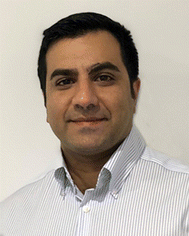Materials Horizons Emerging Investigator Series: Dr Mohammad Mirkhalaf, Queensland University of Technology, Australia
Mohammad Mirkhalaf is a lecturer and Australian Research Council Early Career Fellow at the Queensland University of Technology (QUT). He obtained his PhD from McGill University (Canada), his Master's from Nanyang Technological University (NTU, Singapore), and Bachelor's from Isfahan University of Technology (Iran). After finishing his PhD in May 2015, he joined the National Research Council of Canada as a postdoctoral fellow working closely with his previous lab at McGill till August 2018 when he joined the University of Sydney (USyd, Australia). He joined QUT in January 2022. His research is on tailoring material's internal architecture to improve its mechanical properties and tissue regeneration capacity. He has published 28 original research articles and two invited review articles in high-profile journals, two book chapters, a full US patent, and two patents at the corporation treaty stage. Of the journal articles, he first-authored 18 and last-authored 1: these include publications in leading multidisciplinary journals such as Nature Communications, PNAS, Materials Horizons, Acta Biomaterialia (2x), and Appl. Mater Today (2x) and in leading disciplinary journals in mechanics such as Extreme Mechanics Letters (2x) and Int. J. Solids Struct. He has been the first-named investigator on four successful external grant applications and attracted several prestigious postdoctoral/graduate awards. His experience working at universities, government labs, and industries in Iran, Singapore, Canada, and Australia has enabled him to build solid national and international research partnerships. He has developed and taught two new courses at the USyd, and taught graduate and undergraduate courses at QUT, McGill, and NTU.
Read Mohammad Mirkhalaf's Emerging Investigator Series article ‘Rationally-designed self-shaped ceramics through heterogeneous green body compositions’ ( https://doi.org/10.1039/D2MH00785A ) and read more about him in the interview below:
MH: Your recent Materials Horizons Communication reports a relatively simple and versatile ceramic self-shaping technique. Has your research evolved from your first article to this most recent article and where do you see your research going in future?
MM: My research has always been around developing (a) new fabrication techniques for advanced materials (or devices) and (b) modelling/characterization techniques to reveal new aspects of their structure–function relationships. Throughout my research career, I aimed to move towards broader problems and more straightforward pathways to tackle them, hoping to make my research more plausible scientifically and concurrently more industry viable. In the future, we will focus on materials that combine excellent mechanical properties, sensing, self-repair, shape morphing, and actuation.
MH: What aspect of your work are you most excited about at the moment?
MM: In terms of research, what deviates from mainstream science and engineering is always exciting. Simplifying problems and breaking them into more minor consecutive problems is also exciting, making things easier to build, analyse, and understand. Having the freedom to choose the questions I would like to focus on is quite rewarding.
MH: In your opinion, what are the most important questions to be asked/answered in this field of research?
MM: Nature is highly efficient in making materials that are mechanically, biologically, and optically exceptional in a sustainable way at ambient temperatures and using low energy. These natural materials are also often multifunctional and can sense, self-repair, communicate, actuate and even compute. Can we do similar things in synthetic materials? What are the main design principles behind these natural materials, which are yet unknown? What are the next innovative sustainable green pathways to implement these principles in synthetic materials?
MH: What do you find most challenging about your research?
MM: Being patient and maintaining momentum and excitement over a long period can be challenging and is probably one of the most important assets a researcher, in general, should have. The biggest challenge in my field of research is probably translation to industries. Many exciting materials and devices have been developed in the lab, but few have been translated to real life. This is probably a more serious challenge for bioinspired materials that often structurally deviate from materials used in engineering.
MH: In which upcoming conferences or events may our readers meet you?
MM: I look forward to meeting colleagues at TMS, RMS, ASME IMECE, GCMM, ICEAN and AM&ST.
MH: How do you spend your spare time?
MM: I love walking with my wife, Sareh, speaking with her, and playing with our child, Booseh. I also party with friends, watch movies, swim, and workout.
MH: Can you share one piece of career-related advice or wisdom with other early career scientists?
MM: I keep reminding myself of these: life is much more enjoyable if you have enough space for people around you, like your colleagues/students: Embrace your collaborators. The ones who ask you questions, sometimes challenging questions, are most likely honest people who certainly elevate your work. Embrace them too. It is probably not very important what you decide to do. But take an informed decision, and whatever you do, do it with all your heart. If you see you have done something wrong, don’t be afraid to change: transform yourself. It is not easy, but it is worth a shot.
| This journal is © The Royal Society of Chemistry 2022 |

